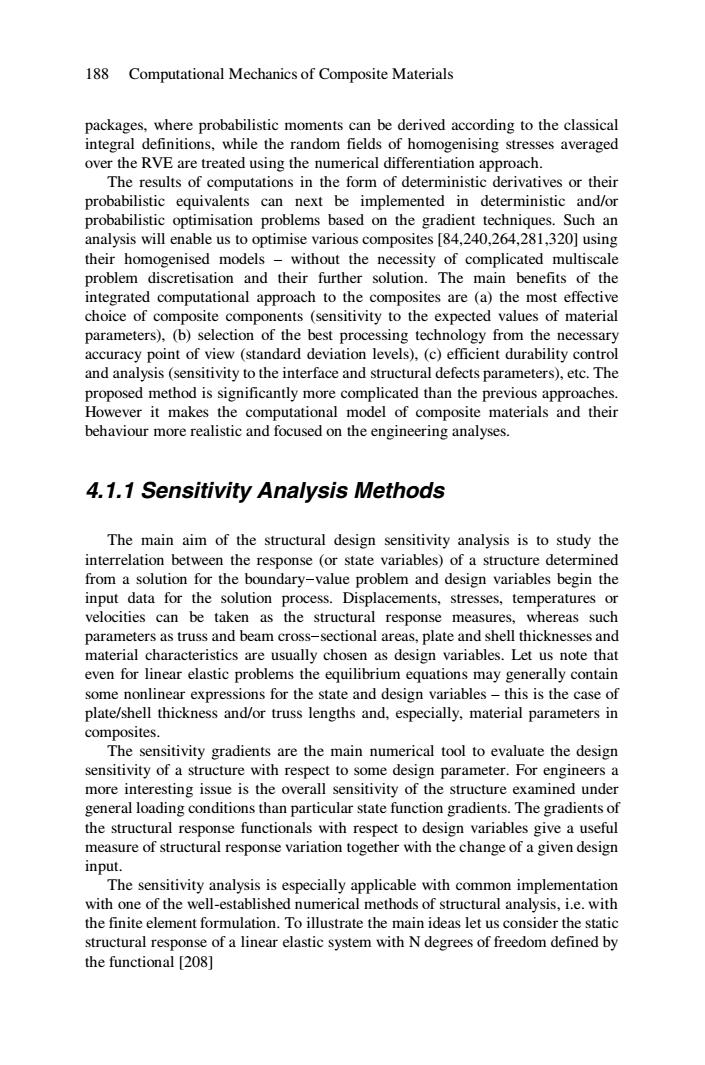正在加载图片...

188 Computational Mechanics of Composite Materials packages,where probabilistic moments can be derived according to the classical integral definitions,while the random fields of homogenising stresses averaged over the RVE are treated using the numerical differentiation approach. The results of computations in the form of deterministic derivatives or their probabilistic equivalents can next be implemented in deterministic and/or probabilistic optimisation problems based on the gradient techniques.Such an analysis will enable us to optimise various composites [84,240,264,281,320]using their homogenised models -without the necessity of complicated multiscale problem discretisation and their further solution.The main benefits of the integrated computational approach to the composites are (a)the most effective choice of composite components (sensitivity to the expected values of material parameters),(b)selection of the best processing technology from the necessary accuracy point of view (standard deviation levels),(c)efficient durability control and analysis(sensitivity to the interface and structural defects parameters),etc.The proposed method is significantly more complicated than the previous approaches. However it makes the computational model of composite materials and their behaviour more realistic and focused on the engineering analyses. 4.1.1 Sensitivity Analysis Methods The main aim of the structural design sensitivity analysis is to study the interrelation between the response (or state variables)of a structure determined from a solution for the boundary-value problem and design variables begin the input data for the solution process.Displacements,stresses,temperatures or velocities can be taken as the structural response measures,whereas such parameters as truss and beam cross-sectional areas,plate and shell thicknesses and material characteristics are usually chosen as design variables.Let us note that even for linear elastic problems the equilibrium equations may generally contain some nonlinear expressions for the state and design variables-this is the case of plate/shell thickness and/or truss lengths and,especially,material parameters in composites. The sensitivity gradients are the main numerical tool to evaluate the design sensitivity of a structure with respect to some design parameter.For engineers a more interesting issue is the overall sensitivity of the structure examined under general loading conditions than particular state function gradients.The gradients of the structural response functionals with respect to design variables give a useful measure of structural response variation together with the change of a given design input. The sensitivity analysis is especially applicable with common implementation with one of the well-established numerical methods of structural analysis,i.e.with the finite element formulation.To illustrate the main ideas let us consider the static structural response of a linear elastic system with N degrees of freedom defined by the functional [208]188 Computational Mechanics of Composite Materials packages, where probabilistic moments can be derived according to the classical integral definitions, while the random fields of homogenising stresses averaged over the RVE are treated using the numerical differentiation approach. The results of computations in the form of deterministic derivatives or their probabilistic equivalents can next be implemented in deterministic and/or probabilistic optimisation problems based on the gradient techniques. Such an analysis will enable us to optimise various composites [84,240,264,281,320] using their homogenised models – without the necessity of complicated multiscale problem discretisation and their further solution. The main benefits of the integrated computational approach to the composites are (a) the most effective choice of composite components (sensitivity to the expected values of material parameters), (b) selection of the best processing technology from the necessary accuracy point of view (standard deviation levels), (c) efficient durability control and analysis (sensitivity to the interface and structural defects parameters), etc. The proposed method is significantly more complicated than the previous approaches. However it makes the computational model of composite materials and their behaviour more realistic and focused on the engineering analyses. 4.1.1 Sensitivity Analysis Methods The main aim of the structural design sensitivity analysis is to study the interrelation between the response (or state variables) of a structure determined from a solution for the boundary-value problem and design variables begin the input data for the solution process. Displacements, stresses, temperatures or velocities can be taken as the structural response measures, whereas such parameters as truss and beam cross-sectional areas, plate and shell thicknesses and material characteristics are usually chosen as design variables. Let us note that even for linear elastic problems the equilibrium equations may generally contain some nonlinear expressions for the state and design variables – this is the case of plate/shell thickness and/or truss lengths and, especially, material parameters in composites. The sensitivity gradients are the main numerical tool to evaluate the design sensitivity of a structure with respect to some design parameter. For engineers a more interesting issue is the overall sensitivity of the structure examined under general loading conditions than particular state function gradients. The gradients of the structural response functionals with respect to design variables give a useful measure of structural response variation together with the change of a given design input. The sensitivity analysis is especially applicable with common implementation with one of the well-established numerical methods of structural analysis, i.e. with the finite element formulation. To illustrate the main ideas let us consider the static structural response of a linear elastic system with N degrees of freedom defined by the functional [208]